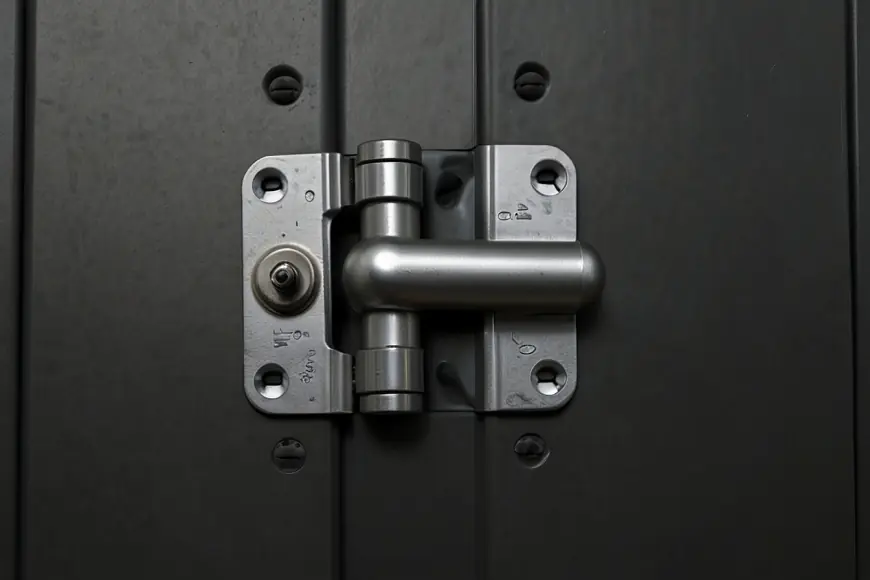Growth Opportunities in Automotive Hinges Market 2030
A primary driver of the global automotive hinges market is the continuous technological advancements in materials and manufacturing processes.

Industry Key Highlights
The global automotive hinges market is undergoing a dynamic transformation, shaped by rapid technological advancements, evolving consumer expectations, and the shift toward sustainable mobility solutions. Valued at USD 5.21 billion in 2024, the market is projected to reach USD 8.21 billion by 2030, reflecting a CAGR of 7.88% during the forecast period. Hinges, a fundamental component of vehicle architecture, play a pivotal role in facilitating the seamless movement of doors, trunks, hoods, and other movable parts. As automotive design becomes increasingly complex and performance-driven, demand for lightweight, durable, and multifunctional hinges is steadily rising.
The market's expansion is further supported by the proliferation of electric and hybrid vehicles, as well as the increasing adoption of autonomous and connected cars. These new vehicle formats call for innovative hinge designs that not only ensure safety and reliability but also integrate seamlessly with smart technologies. Furthermore, global regulatory standards around vehicle safety and emissions are compelling manufacturers to develop eco-friendly, high-performance hinge systems that align with evolving norms.
Increasing investments in vehicle aesthetics and passenger comfort are also contributing to hinge innovation, particularly in luxury vehicles and passenger cars where customization and superior design quality are prioritized.
Emerging Market Trends
1. Rise of Smart Hinges
One of the most disruptive trends in the automotive hinges market is the emergence of smart hinge systems. Equipped with sensors and electronic control units, these hinges support advanced driver assistance systems (ADAS), provide real-time feedback on component status, and improve safety by automatically adjusting the position or locking mechanism in emergencies. Smart hinges are increasingly becoming standard in autonomous and high-end connected vehicles.
2. Lightweighting for Efficiency
OEMs (original equipment manufacturers) are increasingly prioritizing lightweight components to meet fuel efficiency and emissions regulations. This trend has sparked innovations in hinge materials—aluminum alloys, advanced high-strength steels (AHSS), and composite materials are now frequently used. Lightweight hinges contribute not only to vehicle efficiency but also improve performance and ease of operation.
3. Modular and Compact Designs
As carmakers aim to optimize space utilization in vehicle architecture, hinge designs are evolving to become more compact and modular. These allow easier integration with multiple vehicle models and variants, reducing production complexity while offering enhanced flexibility to designers.
4. Customization and Aesthetics
Consumer preference for personalized and luxurious vehicle interiors has prompted automakers to experiment with unique hinge designs, colors, and finishes. Hidden or concealed hinges are gaining popularity for their ability to offer a seamless exterior appearance while retaining full functionality.
5. Eco-Friendly Manufacturing
Sustainability is a major theme across the automotive supply chain, including hinge production. Manufacturers are adopting green manufacturing processes, reducing waste, using recyclable materials, and minimizing emissions during production. This aligns with the global push toward climate-neutral manufacturing.
Download Free Sample Report: https://www.techsciresearch.com/sample-report.aspx?cid=21062
Market Drivers
- Booming Vehicle Production: The global rise in automotive production, particularly in Asia-Pacific and developing economies, is a major contributor to the growing demand for hinges.
- Adoption of EVs and Hybrids: Electric and hybrid vehicles require high-performance, lightweight components that contribute to their energy efficiency goals, thus driving innovation in hinges.
- Focus on Safety and Regulations: Regulatory pressure for safer and more efficient vehicles compels manufacturers to innovate in hinge design, ensuring they meet crash standards and durability tests.
- Demand for Comfort and Convenience: Sophisticated hinge systems enhance passenger convenience by improving door opening angles, reducing effort, and allowing for automation.
- Technological Advancements: Rapid strides in material sciences and precision engineering have led to the development of hinges with greater durability, reduced weight, and added functionalities.
Segmentation Overview
By Vehicle Type
The passenger car segment dominates the global automotive hinges market. This can be attributed to the rising demand for compact and mid-sized vehicles, growing urban populations, and higher disposable incomes. Furthermore, the integration of premium features in passenger cars, such as automatic doors and tailgates, has spurred the adoption of advanced hinges. The growth of electric and connected passenger vehicles has further amplified this demand.
By Product Type
The market includes door hinges, hood hinges, cabinet hinges, and others. Among these, door hinges remain the most widely used segment, owing to their universal application across all vehicle types. However, specialized hinges like hidden or concealed hood hinges are also gaining popularity due to their role in safety and styling.
By Sales Channel
OEMs account for the lion's share of the market. The rise in customized manufacturing, as well as vehicle-specific hinge designs, has fortified the OEM segment. The aftermarket segment, although smaller, is expected to witness steady growth owing to the replacement of worn-out components in aging vehicles.
By Region
Asia-Pacific leads the global automotive hinges market, fueled by robust vehicle production in countries like China, India, and Japan. Rising demand for passenger cars, rapid urbanization, and supportive government policies are contributing to the region's dominance. Europe and North America follow closely, with strong R&D activity and consumer demand for high-performance vehicles.
Competitive Landscape
The automotive hinges market is moderately consolidated, with several key players vying for market share through innovation, strategic partnerships, and global expansion.
Key Players:
- Hettich Holding GmbH & Co. oHG: Known for precision-engineered hinges, Hettich focuses on sustainable and ergonomic solutions.
- Eberhard Manufacturing Company: Specializes in secure and industrial-grade hinge systems tailored for commercial and heavy-duty vehicles.
- Mitsui Kinzoku ACT Corporation: A prominent player offering advanced automotive components with a strong presence in Asia.
- Tenneco Inc.: Through its acquisition of Federal-Mogul, Tenneco delivers both traditional and advanced automotive systems.
- Edscha Holding GmbH: Known for door hinges and closure systems, it serves a wide spectrum of vehicle manufacturers.
- Magna International Inc.: Offers comprehensive automotive solutions including precision hinge systems.
- Aisin Corporation: A major supplier of auto components, Aisin’s hinge solutions focus on energy efficiency and reliability.
- Gestamp Servicios, S.A.: Operates globally, with a focus on lightweight structural components.
- Multimatic Inc.: Provides advanced hinge and structural systems for performance vehicles.
- Saint-Gobain S.A.: Diversified into hinge production with a strong focus on material innovation and quality.
These players are leveraging smart manufacturing, digital modeling, and simulation techniques to improve product design and functionality. Collaborations with EV manufacturers, start-ups, and tech companies are also shaping the competitive landscape.
Future Outlook
The future of the global automotive hinges market looks promising, supported by ongoing innovation and increasing integration with vehicle electronics. Smart hinge systems will become increasingly prevalent, especially in premium and autonomous vehicles. As carmakers strive for greener solutions, the use of recyclable and lightweight materials will gain further traction.
Additionally, advancements in Industry 4.0 technologies—such as AI, IoT, and digital twins—will transform hinge manufacturing by improving precision, predictive maintenance, and performance validation.
With rising disposable income and increased awareness of vehicle aesthetics, the demand for stylish, customized hinges will also soar, especially in developing economies. Government incentives for electric vehicle adoption will add further momentum to the market.
Despite challenges such as raw material price volatility and regulatory compliance, opportunities abound for manufacturers willing to innovate and invest in sustainable practices.
10 Key Benefits of the Research Report
- Detailed Market Forecast: Covers 2020-2030 with CAGR and value projections.
- Comprehensive Segmentation: Analysis by vehicle type, product type, sales channel, and region.
- In-depth Competitive Analysis: Profiles of key global players and strategic insights.
- Emerging Trend Insights: Highlights smart hinges, eco-friendly designs, and more.
- Growth Drivers and Challenges: Identifies market catalysts and restraining factors.
- Technological Landscape: Explores material and engineering innovations.
- Regional Insights: Breaks down opportunities by global regions.
- OEM and Aftermarket Focus: Evaluates sales dynamics and potential across channels.
- Policy and Regulation Overview: Covers how global standards impact market trends.
- Customizable Findings: Offers 10% free customization based on client needs.
Contact Us-
Mr. Ken Mathews
708 Third Avenue,
Manhattan, NY,
New York – 10017
Tel: +1-646-360-1656
Email: [email protected]
Website: www.techsciresearch.com
What's Your Reaction?
 Like
0
Like
0
 Dislike
0
Dislike
0
 Love
0
Love
0
 Funny
0
Funny
0
 Angry
0
Angry
0
 Sad
0
Sad
0
 Wow
0
Wow
0

















































